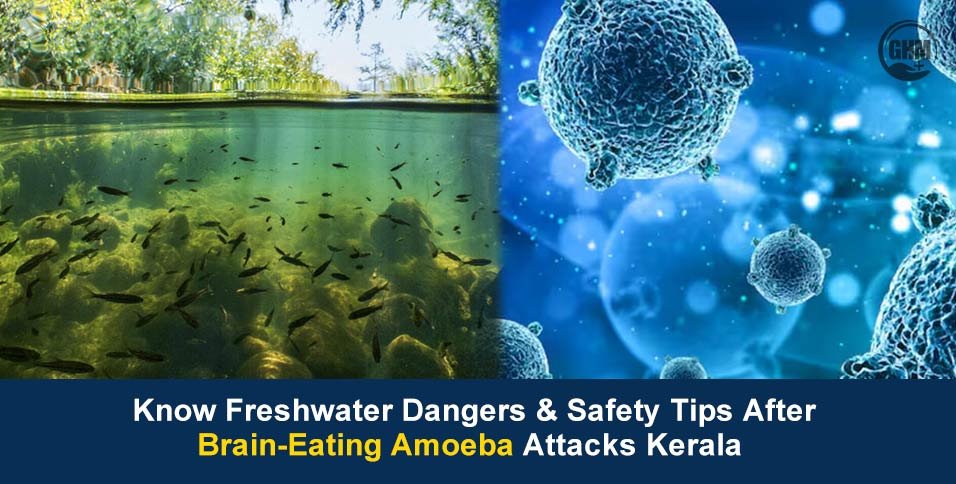Kerala is currently facing a concerning health crisis due to a surge in infections caused by the brain-eating amoeba, scientifically known as Naegleria fowleri. Since the beginning of 2025, the state has recorded approximately 69 confirmed cases and 19 deaths linked to this deadly outbreak. This situation is responsible for primary amoebic meningoencephalitis (PAM) infection.
Unlike previous years when outbreaks were traced to specific water sources, cases this year are widespread and sporadic, making tracking and prevention efforts more complicated for health officials. Public health experts warn that this is not an isolated incident. As temperatures rise and water sources warm, the risk of such infections is expected to increase worldwide.
Freshwater: A Hidden Danger
While most people associate clean-looking water with safety, many microorganisms thrive in freshwater environments like lakes and poorly maintained pools, particularly in warm, stagnant water. The brain-eating amoeba is one of the most dangerous organisms.
When contaminated water enters the nose, the amoeba can migrate to the brain and cause primary amebic meningoencephalitis (PAM), a disease that quickly destroys brain tissue and causes fatal brain swelling.
Early symptoms of PAM appear within two to fifteen days after exposure and include severe headache, fever, nausea, vomiting, and a stiff neck. As the infection progresses, it can lead to confusion, seizures, coma, and death, often within one to two weeks. The effects are swift and devastating, with a mortality rate of more than 97% even with treatment.
There is no single cure for PAM. Aggressive therapy using antifungal and antimicrobial drugs is the standard approach. Early diagnosis and immediate intervention improve survival chances, though they remain slim. Prevention, such as avoiding untreated water sources and using nose clips, is the most effective strategy.
Warm Climates at Higher Risk
Rising global temperatures have created an ideal environment for the brain-eating amoeba and similar microorganisms.
- Warmer water provides a perfect breeding ground for amoebae.
- Increased recreational use of lakes and rivers during heat waves raises exposure.
- Climate change-related flooding can spread contamination to new areas.
According to a 2024 report by the World Health Organization (WHO), waterborne infections are expected to increase by 15% globally by 2030, largely due to warming trends and population growth in tropical regions.
Past Cases and Global Trends
Kerala has seen at least five confirmed cases of PAM in the past two years, with a high fatality rate. This mirrors a worrying trend in other warm regions around the world.
- United States: The U.S. Centers for Disease Control and Prevention (CDC) reports 0–8 cases annually, mostly in southern states like Florida and Texas.
- Australia: Sporadic cases have been linked to inadequately treated public water systems.
- Pakistan: Karachi has reported multiple outbreaks in recent years due to poor water and sanitation.
In India, Kerala has become a hotspot due to its tropical climate and extensive network of freshwater bodies. The recent cases have prompted an urgent review of water treatment and public health awareness programs.
Preventive Actions By Officials
Public health teams are the first line of defense when such outbreaks occur. In Kerala, health officials immediately launched a chlorination drive after the latest cases were reported. They also tested water samples from affected areas and issued advisories to local communities.
Steps Taken During Outbreaks:
- Water Testing and Treatment:
Contaminated sources are identified and treated with chlorine or other disinfectants.
- Community Awareness Campaigns:
Informing residents about safe water practices, such as boiling water and avoiding nasal exposure.
- Rapid Diagnosis Training:
Hospitals are instructed to test for rare infections like PAM in suspected meningitis cases.
- Surveillance Systems:
Tracking waterborne infections to prevent further spread.
“The symptoms headache, fever, and vomiting are similar to bacterial and viral brain infections. If you don’t suspect amoeba, you’ll miss it completely,” said Dr Rajeev Jayadevan, convener of the Indian Medical Association’s research cell.
How to Protect Yourself and Your Family
While infections from brain-eating amoeba are extremely rare, it is vital to take precautions, especially during the summer months or in warmer regions.
Safety Tips:
- Avoid swimming in untreated freshwater lakes or rivers during hot weather.
- Use boiled or distilled water for nasal rinses.
- Wear nose plugs while swimming or diving in natural water bodies.
- Ensure domestic water tanks are cleaned and chlorinated regularly.
- Follow local health advisories during outbreaks.
Need For Building Safer Communities
The rise in waterborne diseases highlights the need for stronger public health infrastructure. Governments and communities must work together to improve water treatment systems, monitor environmental changes, and raise public awareness.
By learning from past outbreaks and Kerala’s ongoing struggle to global responses, societies can better prepare for emerging threats. Addressing these hidden health risks is not just about preventing rare infections like PAM, but also about safeguarding communities from a wide range of waterborne diseases.
Conclusion
Freshwater is essential to life, but it can also hold unseen dangers. The recent cases in Kerala are a stark reminder that brain-eating amoeba and other harmful organisms thrive in warm, untreated water. With climate change accelerating these risks, a proactive approach to water safety is more critical than ever.



















